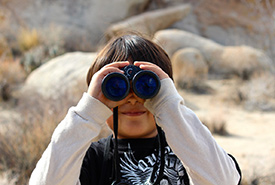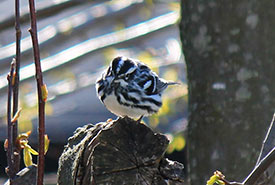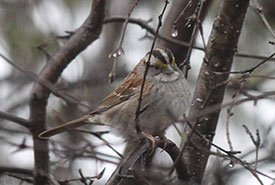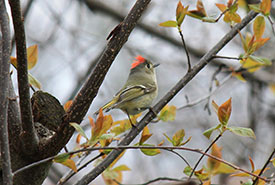Birding for beginners

Child with binoculars (Public Domain)
I wouldn’t consider myself a birder, but I am one of the many people who started getting more tuned into the nature around me when the pandemic started. Working from home and making a habit of taking walks around my neighbourhood has made me more aware of my surroundings and given me a rare opportunity to appreciate the nature in my backyard. If you’re looking for a new hobby or are feeling bored of your surroundings, I encourage you to give birding a try.
Related content:
Why birding is great

Black and white warbler (Photo by Pia Vahabi/NCC staff)
- It can be done anywhere. You could travel halfway across the world to go birding, or you can do it from your balcony in downtown Toronto.
- You don’t need anything to get started. Binoculars and a bird ID app or book are super helpful, but you can even start just by listing the birds that you already recognize as you walk around your neighbourhood.
- You can be as serious or casual about it as you want. I’m happy to just ID the birds I see while gardening, having my morning coffee or on a walk with the dog. Others may enjoy spending hours every morning visiting different spots to find as many birds as they can.
- It’s an excuse to spend time in nature. There are many health benefits to spending time in nature, and even just sitting and looking at trees has been shown to reduce stress.
- It helps with mindfulness. When you’re trying to track down a bird or paying attention to every detail of a bird you’re looking at, it’s hard to think about anything else.
- It helps you appreciate and connect with nature. Working at the Nature Conservancy of Canada, I’ve gotten to play a role in protecting large chunks of habitat across the country. The last few months have helped me feel more connected to the ecosystem close to me. I’m still inspired to protect the big stuff, but now I’m feeling a greater responsibility to take care of my small patch of nature to ensure I’m providing the best possible habitat for the wildlife around me.
How to get started

White-throated sparrow (Photo by Pia Vahabi/NCC staff)
- Buy a pair of binoculars. Quality makes a difference, but even a basic pair will help you see further. Check out the Cornell Lab of Ornithology's article on how to choose an affordable pair of binoculars >
- Spend time in your yard (or at your window) observing your surroundings. Spending a few minutes just sitting in the backyard every day has helped me realize just how much wildlife is out there. Some days I see a bunch of new species, other days just a squirrel, but either way I end up feeling refreshed from spending a few quiet moments enjoying my morning coffee and the fresh air.
- Pay attention to what’s going on around you. Working home alone all day with few distractions has meant that I’m paying more attention to what’s happening outside my home office window. I’ve gotten into the habit of keeping my binoculars and camera at my desk and bringing them with me when I’m outside. Whenever I see something fluttering from the corner of my eye, I look up to see what it is.
How to identify the bird

Ruby-crowned kinglet (Photo by Pia Vahabi/NCC staff)
- Get to know your regular visitors. Over the last two months, I’ve gotten better at identifying a cardinal, blue jay, mourning dove, grackle, starling or robin based on shape, flight pattern and sound. Now, I’m much quicker to spot something that looks or sounds different, and I can better describe a new species by comparing it to ones I’m more familiar with.
- Pay attention to size, shape, habitat and colour. The combination of my poor-quality binoculars and the fast movement of birds makes it hard for me to see details in colouring. Once I’ve taken note of the primary colours I see, I move on to other identifiers. What size is it compared to other birds I know? What shape is it? How long is its tail compared to its body? Is its beak long and slender or short and thick? Where is it and what is it doing? This has been especially helpful for all the “small, brown birds” in my neighbourhood, which are apparently not all sparrows. Note that many birds have different plumages depending on age, sex and season.
- Make use of apps, websites and books. I primarily rely on my Birds of Ontario book, the Merlin app, iNaturalist and eBird for identifying and keeping track of what I’m seeing. eBird and iNaturalist are especially great because you can zoom into your location and see what species has been sighted nearby recently or in previous years. There are many other field guides available to assist with identifying birds.
- Find someone who can help you, and don’t be afraid to ask them "silly" questions. I’ve been leaning a lot on colleagues to help me with my never-ending questions ranging from “What is this blurry brown blob?” to “Is it possible that there’s a black-throated green warbler in my backyard?” If joining a field naturalist group isn’t possible or feels daunting, there are lots of great online groups and message boards full of people happy to help you.


